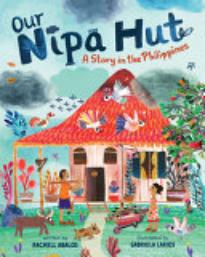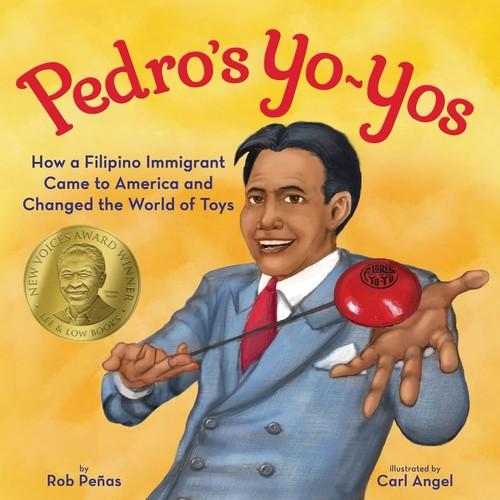Tagalog language
6 Reviews
(2)
K-3
Illustrated by
Gabriela Larios.
"The nipa hut is family too." Yelena Mendoza lives in a traditional nipa hut in the Philippines with her family. Made from palm leaves and bamboo, the structure has stood for many generations, lovingly cared for and repaired by its inhabitants when it needs "a change of clothes." During a big storm, the nipa hut "sways," "shakes," and "flinches." A gust of wind pushes the windows open, bringing in rain and cold; are "Yelena and the nipa hut...no match for the storm"? With Papa's help, they make it through -- though afterward the nipa hut is in need of repairs. "'You will be okay,' [Yelena] says. 'Thank you for taking care of us.'" Abalos's warm text is true to a child's perspective; Larios's color-saturated illustrations, teeming with wildlife and plants native to the Philippines, have a compellingly naif quality. Details in the art enhance the story: Papa has a prosthetic leg; a framed portrait on the wall might be Yelena and baby brother Marco's mother, whom the story doesn't mention. An author's note dives deeper into the history and architectural influence of the nipa hut (its structural flexibility inspired the first skyscraper), the Philippines, and climate change and includes a glossary of Tagalog words.
Reviewer: Gabi K. Huesca
| Horn Book Magazine Issue:
July, 2024
(2)
K-3
Illustrated by
Carl Angel.
Born in 1896 under Spanish colonial rule in the Philippines, Pedro Flores immigrated to the United States as a teenager. It wasn't until years later -- after he had worked in Hawaiian pineapple fields, on steamships in the Pacific, and at a hotel in California -- that he produced the first Flores yo-yo. Though Flores did not invent the toy (Peñas traces its origins back thousands of years to China), his ingenious reengineering of it led to its rise in popularity (the word yo-yo means "come back" in Tagalog). Peñ as's straightforward text is well supported by deeply saturated images that illustrate Flores's experience as an immigrant: long hours of physically demanding labor and the dogged pursuit of education. It was with the help of a neighbor that Flores was able to start his business, and he committed to bringing his fellow kabayan into his success, as employees. Readers will delight in learning (or remembering) how to "Rock the Baby," "Loop the Loop," and "Walk the Dog." An author's note provides history about the Philippines, the yo-yo, and Flores's life.
Reviewer: Gabi K. Huesca
| Horn Book Magazine Issue:
May, 2024
(2)
K-3
Illustrated by
Daniel Tingcungco.
Following a typhoon in the Philippines, Maya discovers a corrugated metal roof that has fallen into her yard. Maya and Tatay (her father) embark on a journey to return the thin roof, folded up "like a lumpia," to its owners. Along the way, Maya and Tatay witness the aftermath of the massive storm: a swollen river, fallen trees, and, eventually, a house missing part of its roof. They also meet people who are eager to help: "a sapatero, some pearl divers, a pig breeder, a labandera," and more. Tingcungco's digital mixed-media art with thick, densely saturated brushstrokes illustrates the beauty of the Philippines and of community as well as the gravity and destructiveness of natural disasters. Readers are introduced to the biodiverse landscapes of the islands, their waterfalls, mountains, and giant palms and ferns; as well as species native to the land, including carabao, fiddler crab, needle fish, and egrets. The dramatic perspectives -- on top of the roof, in the depths of the woods, underwater -- evoke in readers a feeling of being part of the mission to reunite the roof with its family. In an author's note, Sy explains this feeling, bayanihan, or being in community. Also appended are illustrated translations of the professions named earlier in Tagalog of those who helped along the way.
Reviewer: Gabi K. Huesca
| Horn Book Magazine Issue:
November, 2024
(2)
YA
When Bobby Agbayani is forcibly outed as gay to his entire school, an onslaught of bullying ensues. Despite his tight-knit social support, Bobby wasn't fully ready to be out publicly, given the conservative Catholic values of some in his Filipino American community. After bullies beat him up and steal his late father's bicycle, Bobby decides to learn to defend himself ("self preservation" is his personal motto). He finds a job cleaning a grimy boxing gym, where he learns about the sport and about legend Manny Pacquiao...but then (real-life) homophobic comments from his idol are painful to reconcile. This ode to the queer Filipino American experience touches on the history of significant Filipino Americans and how they have influenced future generations. Pulido's seamless use of Tagalog, coupled with Bobby's occasional tanaga (traditional Indigenous Filipino poetry), adds another dimension to the book's examination of what it means to be Filipino American. Through Bobby's journey of naming his identity, the book explores what it means to grow up in as diverse a place as Los Angeles and still feel isolated, and grapples with heroes who reveal their flaws and complexity.
Reviewer: Gabi K. Huesca
| Horn Book Magazine Issue:
May, 2023
(4)
K-3
Translated by Eloisa D. de Jesús.
Illustrated by
Carl Angel.
On a walk through his neighborhood, Lakas meets several street performers and follows one of them--the Karaoke King--home to the Makibaka Hotel. While there, he discovers that the residents are being evicted and rallies them to protest. The tropically hued illustrations have plenty of bounce, and while the bilingual (English and Tagalog) story is wordy, its themes and context are unique.
Reviewer: Roger Sutton
(2)
K-3
Translated by Eloisa D. de Jesus.
Illustrated by
Carl Angel.
In this bilingual English/Tagalog story, a boy's father takes him to buy a fish in a shop in Manilatown, San Francisco's historic Filipino-American neighborhood. After speaking to the boy, the fish runs off, with the boy, his father, and the fish-store man in hot pursuit. Kids will be captured by the loopy story and the rollicking, high-colored, bang-bang pictures.
6 reviews
We are currently offering this content for free. Sign up now to activate your personal profile, where you can save articles for future viewing.









